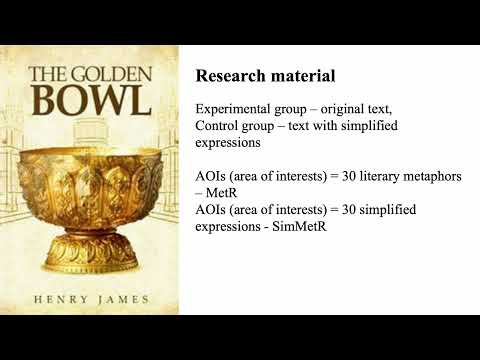 Speaker: Monika Płużyczka @Monika & Ainur Kakimova @Ainur
Speaker: Monika Płużyczka @Monika & Ainur Kakimova @Ainur
 Affiliation: University of Warsaw
Affiliation: University of Warsaw
Title: Processing and Aesthetic Appreciation of Literary Metaphors in Foreign Language. An Eye Tracking Study
Abstract (long version below): When reading a literary text in a foreign language, do we take longer to process metaphors than non-metaphorical expressions? And how do we evaluate the aesthetic value of metaphors in a foreign language? Is there any correlation between the difficulty of metaphors understanding and their aesthetic appreciation? The presentation aims to answer these questions on the basis of empirical research.

 Long abstract
Long abstract
According to the neurocognitive model of literary reading (Jacobs, 2011), foregrounding devices are processed slower and are aesthetically appreciated in contrast to backgrounding elements. Studies that support the model involve native speakers. However, empirical research on the processing of foregrounding in a foreign language is scarce. It is of special relevance, as we live in a multicultural society where reading literature in a second language is becoming increasingly common.
The aim of the presentation is to explore the processing and appreciation of literary metaphors by English as a second language speakers (ESL). While there is no scholarly consensus on whether understanding metaphors is cognitively demanding and take longer time to process than do other elements in a sentence, even less research exists concerning the processing of metaphors in a foreign language by non-native speakers (NNS). Some propose a three-stage model of metaphor comprehension during which the non-native speaker first considers the literal meaning. Others support the concept of a universal pattern of metaphor comprehension independent of the language. However, there is still little empirical research to support either approach. The research presented here not only fills this gap but also shows whether metaphors in a foreign language are aesthetically appreciated by NNS readers.
Four research problems were set in the scope of the paper: the perception of literary metaphors in the second language; the cognitive effort involved in the comprehension of such metaphors; the understanding of literary metaphors in a foreign language; the aesthetic appreciation of literary metaphors by ESL speakers. The results of the pilot eye-tracking experiment as well as comprehension scores showed that literary metaphors are more difficult to comprehend and take longer to process than do their equivalents, simplified versions. Additionally, research (appreciation tests) showed that readers aesthetically appreciate the literary metaphors in foreign language more than they do their equivalents rewritten in plain language. We found also a correlation between the difficulty of the metaphor and the higher aesthetic rating.
To explore this topic in more depth, we carried out eye-tracking experiments on a larger group of subjects and added selected methodological tools. We used self-response questionnaires such as complexity assessment and aesthetical evaluation (based on Knoop et al. 2016) to check the correlation between the two variables. We also received feedback from participants on why they found specific metaphors aesthetically pleasing using retrospective think aloud protocols. Additionally, we checked the correlation between foregrounding and absorption, as recent studies suggest that these features are not mutually exclusive (e.g., Balint et al., 2017). By using triangulation of methods, we aimed to gain a more comprehensive understanding of how non-native readers engage with foregrounding in a literary text and what affects the aesthetic appreciation of metaphors in a foreign language.
References
Jacobs, A. M. (2011). “Neurokognitive Poetik: Elemente eines Modells des literarischen Lesens (Neurocognitive Poetics: Elements of a Model of Literary Reading),” in Gehirn und Gedicht: Wie wir unsere Wirklichkeiten konstruieren (Brain and Poetry: How We Construct Our Realities), eds R.
Schrott and A. M. Jacobs (München: Carl Hanser Verlag), 492–520.
Knoop, C. A., Wagner, V., Jacobsen, T., & Menninghaus, W. (2016). Mapping the aesthetic space of literature “from below”. Poetics, 56, 35-49.
Bálint, K., Hakemulder, F., Kuijpers, M., Doicaru, M., & Tan, E. S. (2016). Reconceptualizing foregrounding: Identifying response strategies to deviation in absorbing narratives. Scientific Study of Literature, 6(2), 176-207.

